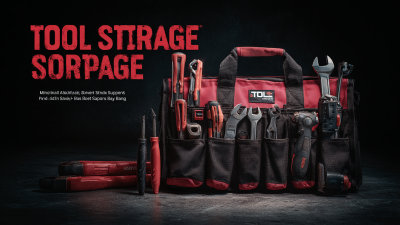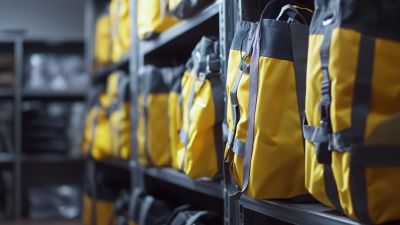- 0086-0769-87986375
- Welcome you to Dongguan Yili Bags Co., Ltd. website!
Unlocking Longevity: The Science Behind Choosing the Most Durable Tool Bag for Your Needs
In the quest for longevity and efficiency in tool organization, selecting the right Durable Tool Bag is paramount. According to a recent industry report by The Tool Industry Association, the demand for high-performance tool bags has surged by 25% over the past three years, reflecting a significant shift towards durability in professional and DIY settings. This increase is driven by professionals who recognize that a well-constructed tool bag not only protects their investment in tools but also enhances productivity by ensuring easy access and organization.

Furthermore, studies indicate that the material quality of tool bags significantly impacts their lifespan and effectiveness. Reports from Durable Goods Manufacturers suggest that tool bags made from high-denier materials and reinforced stitching can last up to three times longer than their lesser counterparts. This durability translates into lower replacement costs and less downtime on jobs, which is crucial for tradespeople operating in competitive environments. Thus, investing in a Durable Tool Bag is not merely a choice of convenience but a strategic decision that contributes to long-term success in the field.
Understanding Tool Bag Durability: Key Factors to Consider
When it comes to selecting the most durable tool bag, understanding the factors that contribute to longevity is crucial. According to a report from the Tool and Equipment Manufacturers Association, nearly 70% of professionals cite durability as the most important criterion for tool bags, specifically highlighting materials and construction quality. Premium materials such as rip-resistant nylon and high-density polyester not only withstand the rigors of daily use but also resist wear and tear over time. Choosing tool bags with reinforced stitching and heavy-duty zippers can significantly enhance their lifespan, making them ideal for both casual users and industry professionals.
Another key aspect is the load-bearing capacity. Research from the American National Standards Institute indicates that tool bags designed to carry over 50 pounds must undergo rigorous testing to ensure structural integrity. Most high-quality tool bags are equipped with reinforced handles and padded straps, which help distribute weight evenly and reduce the risk of failure while in use. Furthermore, water-resistant features can protect tools from moisture, ensuring they remain functional for a longer period. When making a decision, examining these essential characteristics can lead to an informed choice that aligns with your specific needs, ultimately unlocking the longevity of your bag and the tools it carries.
Unlocking Longevity: The Science Behind Choosing the Most Durable Tool Bag for Your Needs
| Feature | Description | Importance Level |
|---|---|---|
| Material Quality | High-grade materials like canvas or synthetic fibers that resist wear and tear. | High |
| Zipper Type | Heavy-duty zippers that won't snag or break easily over time. | Medium |
| Stiching Reinforcement | Double or triple stitched seams for added strength and durability. | High |
| Weight Capacity | Ability to carry a significant load without compromising the structure. | High |
| Weather Resistance | Waterproof or water-resistant features to protect tools from moisture. | Medium |
| Padding and Protection | Internal padding to protect tools from impact and scratches. | Medium |
| Storage Options | Multiple compartments for organized storage of tools and accessories. | High |
Materials Matter: Choosing the Right Fabric for Longevity
When selecting a durable tool bag, the choice of fabric is paramount to ensure longevity and resilience.
Nylon 66, known for its strength and abrasion resistance,
is projected to have a market value of approximately $451.77 million by 2025,
with expectations to soar to $733.18 million by 2033, reflecting a
compound annual growth rate (CAGR) of 6.24%. This growth indicates a
rising recognition of high-performance materials in various applications, including tool bags that must withstand rugged conditions.
Additionally, the expansion of the textile industry underscores the importance of selecting materials that not only perform well
but also have a sustainable lifecycle.
Tips: When choosing a tool bag, consider fabrics like
Nylon 66 for their superior durability and long lifespan.
Ensure that the bag you select is designed for heavy usage, as this will ultimately save you from frequent replacements
and enhance your efficiency on the job.
Furthermore, the global polyester fiber market is also witnessing notable growth, with an expected rise from
$820.7 billion in 2025 to
$1.3 trillion by 2032, portraying the market's shift toward materials that meet
both functional and eco-friendly demands. Opting for tool bags made from such
innovative materials can provide the necessary durability while aligning with sustainable practices.
Tips: Always review the fabric specifications
and seek out tool bags that incorporate advanced materials for maximum wear resistance and environmental sustainability.
Design Features that Enhance the Durability of Tool Bags
When selecting a durable tool bag, understanding the design features that enhance longevity is crucial. High-quality materials, such as nylon or polyester, are essential for resistance against wear and tear, with a recent industry report indicating that tool bags made from 1680D ballistic nylon can last up to 50% longer than those made of cheaper fabric options. Reinforced stitching and heavy-duty zippers further contribute to overall durability, preventing rips and ensuring the bag can withstand daily use in various environments.
Tips: Look for tool bags with reinforced bottoms, as they not only provide extra support but also protect against moisture and dirt, thus extending their lifespan. Additionally, consider a bag with multiple compartments, which helps distribute weight and reduces strain on the material, further enhancing its durability.
Another key feature to consider is weather resistance. Tool bags designed with water-resistant coatings or treatments can protect your tools from moisture damage, which is especially important in outdoor settings. Reports suggest that tool bags equipped with this feature can reduce moisture-related tool failure by up to 70%, ensuring longevity for both the bag and its contents.
Maintenance Tips to Extend the Life of Your Tool Bag
To maximize the lifespan of your tool bag, proper maintenance is crucial. Regular cleaning should be a top priority; dirt and debris can accumulate over time, leading to wear and tear. Use a soft brush or a damp cloth to remove dust and grime from both the exterior and interior. For fabric tool bags, consider using a gentle detergent to wash away stubborn stains. Ensuring your tool bag is clean not only maintains its appearance but also prolongs its functionality.
Another key aspect of maintenance involves proper storage. Avoid overloading your tool bag, as excess weight can strain the seams and zippers. Instead, organize your tools by size and type to distribute weight evenly. When not in use, store your bag in a cool, dry place away from direct sunlight, which can degrade materials over time. Regular inspections for any signs of damage, such as frayed edges or weak stitching, will allow for timely repairs, preventing minor issues from escalating into significant problems. Following these maintenance tips can substantially enhance the durability of your tool bag, ultimately ensuring it serves you well for years to come.
Tool Bag Durability Comparison
This bar chart illustrates the various factors contributing to the durability of tool bags, rated on a scale from 1 to 10. Materials, zipper strength, seam reinforcement, water resistance, and weight capacity are essential for selecting a tool bag that will last.
Selecting the Right Size and Weight for Your Tool Bag Needs
When selecting the right tool bag, assessing size and weight is crucial for efficiency and comfort. A bag that's too large can lead to unnecessary bulk, making it cumbersome to transport. Conversely, a too-small bag forces you to compromise on necessary tools, which can hinder your projects. Therefore, it's essential to evaluate the specific tools you typically carry.
Consider organizing your tools and categorizing them based on frequency of use—this will help you determine the optimal bag size that suits your workflow.
Weight also plays a significant role in your selection process. A heavier tool bag may offer more durability, but if it's too heavy to carry comfortably, it can lead to fatigue and decreased productivity over time. Look for materials that combine strength with lightweight properties, such as high-denier nylon or reinforced polyester.
Furthermore, a well-designed bag that distributes weight evenly will enhance portability. Ultimately, finding the right balance between size, weight, and durability will ensure that your tool bag remains a reliable companion on all your projects, contributing to a longer-lasting and more effective tool organization system.
Related Posts
-

Maximizing After Sales Support and Repair Savings with the Best Tool Storage Bag
-

Innovative Strategies for Efficient Storage with Large Capacity Tool Bags
-

Maximize Your Global Reach with Innovative Makeup Organizer Bag at the Successful 137th Canton Fair
-

7 Reasons Why You Need a Cable Storage Bag in Your Life
-

Exploring Unique Designs of Musical Carrying Bags: A Look at Creative Examples
-

Maximizing Opportunities for Cable Organizer Bag Sales at the 138th China Import and Export Fair 2025
